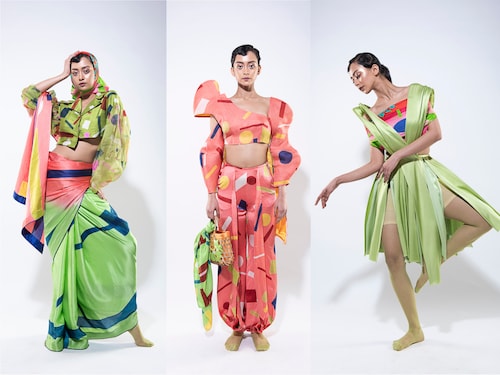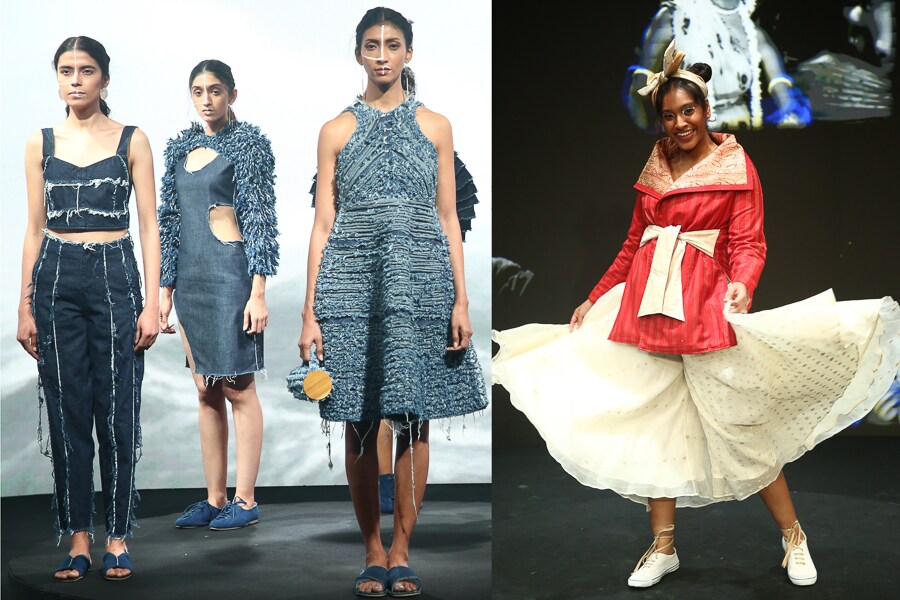Geometric prints, patches, drapes: Vintage meets biodegradable in the latest sus
Here are some of the latest eco-friendly fashion collections that define conscious luxury



Purn Vritt, Cocccon by Chandra Prakash Jha and Georg
Trashion (art, jewellery, fashion, home décor objects created from waste material), eco-friendly and sustainable are the biggest trends in today’s world of luxury, heavily impacted and influenced by the pandemic.
Luxury consumers have become conscious shoppers, constantly thinking of the consequences of their purchases. Fashion designers too are creating outfits that have a minimal impact on the planet.
Here are some of the latest eco-friendly fashion collections that define conscious luxury.
Purn Vritt, Cocccon by Chandra Prakash Jha and Georg
Cocccon’s Purn Vritt collection, which has colourful, vibrant and futuristic outfits, is made from biodegradable materials, including organically produced peace silk (non-violent silk breeding and harvesting, which allows the completion of the metamorphosis of the silkworm to butterfly, so that no animal must suffer or die for fashion). The collection also uses no plastic in its outfits. There are printed saris with long- sleeved cholis, pleated yoke blouses, summer dresses with ruffled necklines and balloon or rectangular sleeves, draped lungis and pleated skirts.
Geometry is the mainstay of the prints, as circles, squares, rectangles and linear patterns jostle on the bright hues.
Mismatched by Ritu Kumar
Ritu Kumar’s spring/summer 2021 collection, Mismatched, has been made with natural and recyclable fibres—viscose sourced from the bark of trees, organic cotton, plant-based fibres, and, in some instances, even wool and soya silk.
While the collection celebrates traditional textile crafts like bandhani, suzani, aari work, rabari embroidery and sanganeri prints, the outfits celebrate modern minimalism. Yarn dyes, mix and match floral prints, patchwork with different types of laces and geometric designs come together in her line of lightweight summer saris and dresses.

Mismatched by Ritu Kumar(L) and X, Bloni by Akshat Bansal(R)
X, Bloni by Akshat Bansal
Bloni’s newest collection X is made from marine plastic waste. The edgy, party-worthy dresses and pant suits blend tech-generated fabrics with local artisanal techniques such as tie-dye, hand crochet and knitting along with glazed fabrics, clean silhouettes, and gender-neutral shapes.
Human Nature, The Chola by Sohaya Misra
Chola’s organic cotton comes from Puducherry, post-consumer waste recycled cotton is from Tirupur (in Tamil Nadu), handwoven khadi from West Bengal, muls from Bhopal and pure linens from various states of India, depending on the availability and requirement. Recycled and upcycled or biodegradable materials are used by the designer, while textile scraps are used for pockets or collars of garments that are all made in-house.
Misra’s new collection Human Nature, in black and white, merges simplicity and complicated visuals along with strings, buttons, loops and straps, detachable hoods and sleeves in striped robes, wide flowing pants, high-collared blouses, hoodies and tunics.
Nece Gene by Neha Celly
Founder and designer of Nece Gene, Neha Celly’s new collection of upcycled denim couture is made from denim waste from Arvind Mills, one of India’s largest manufacturers of denims. Nece Gene uses the waste to make garments, clutches, and bags. And the very small scrap and fibre is made into pulp and used to make indigo paper and books.

Nece Gene by Neha Celly (L) and Latasita by Meghna Nayak (R)
Latasita by Meghna Nayak
Megha Nayak’s collection of festive and smart skirts, jackets, robes, rompers, short hoodies and summer dresses, called Fed with Waste, is constructed from old, heirloom, unused, discarded, wasted material.
A cutting technique that leaves minimum waste was used to make the clothes. Some of the garments have four to eight layers of waste fabric, making for a perfect drape. The remaining waste was given to local artisans to create sanitary pads, stuffed toys, pillows, and mattresses.
Paiwand by Ashita Singhal
Singhal’s textile studio upcycles textile waste, using various handcrafted techniques like handloom weaving, patchwork, knitting, embroidery, and felting, and turns it into fabrics for apparel and home furnishing.
Their newest collection Paiwand has embroidered dresses, kurtas, pants, bomber jackets and knee-length swing coats.

Paiwand by Ashita Singhal (L) and Grandma Would Approve by Priyanka Muniyappa (R)
Grandma Would Approve by Priyanka Muniyappa
The label looks for cotton, silk, corduroy and other garments that are 30-50 years old and gives them new shapes and forms. Their reconstruction through deconstruction technique combines the material of 10-15 garments to create hand-cut puzzle pieces of 50-100 panels, which in turn creates a unique fabric that has vivid colours, textures and prints. These are then used to make edgy multi-patched coats, tunics, pants, and pouches.
First Published: Apr 17, 2021, 10:00
Subscribe Now